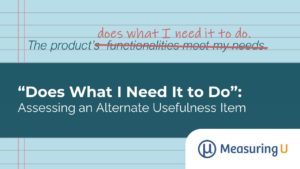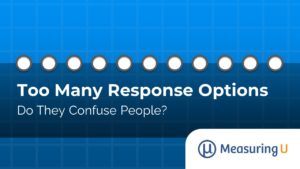Topics
Topics

The Anatomy of a Survey Question
We’ve written extensively about question types, the elements of good and bad writing, why people forget, and common problems with survey questions. But how do you get started writing questions? Few professionals we know have taken a formal course in survey development and instead rely on their experiences or best practices. Despite being called questions,

“Does What I Need It to Do”: Assessing an Alternate Usefulness Item
The UMUX-Lite is a two-item standardized questionnaire that, since its publication in 2013, has been adopted more and more by researchers who need a concise UX metric. Figure 1 shows the standard version with its Perceived Ease-of-Use (“{Product} is easy to use”) and Perceived Usefulness (“{Product}’s capabilities meet my requirements”) items. Figure 1: Standard

A Decision Tree for Picking the Right Type of Survey Question
Crafting survey questions involves thinking first about the content and then about the format (form follows function). Earlier, we categorized survey questions into four content types (attribute, behavior, ability, or sentiment) and four format classes (open-ended, closed-ended static, closed-ended dynamic, or task-based). As with any taxonomy, there are several ways to categorize response options (e.g.,

Statistical Hypothesis Testing: What Can Go Wrong?
Making decisions with data inevitably means working with statistics and one of its most common frameworks: Null Hypothesis Significance Testing (NHST). Hypothesis testing can be confusing (and controversial), so in an earlier article we introduced the core framework of statistical hypothesis testing in four steps: Define the null hypothesis (H0). This is the hypothesis that

Classifying Survey Questions into Four Content Types
In architecture, form follows function. In survey design, question format follows content. Earlier we described four classes of survey questions. These four classes are about the form, or format, of the question (e.g., open- vs. closed-ended). But before you can decide effectively on the format, you need to choose the content of the question and

Do Too Many Response Options Confuse People?
Advice on rating scale construction is ubiquitous on the internet and in the halls of organizations worldwide. The problem is that much of the advice is based not on solid data but rather on conventional wisdom and what’s merely thought to work. Even published papers and books on survey design can present a perspective that

Four Types of Potential Survey Errors
When we conduct a survey, we want the truth, even if we can’t handle it. But standing in the way of our dreams of efficiently collected data revealing the unvarnished truth about customers, prospects, and users are the four horsemen of survey errors. Even a well-thought-out survey will have to deal with the inevitable challenge

How Does Statistical Hypothesis Testing Work?
Statistically significant. p-value. Hypothesis. These terms are not only commonly used in statistics but also have made their way into the vernacular. Making sense of most scientific publications, which can have practical, significant effects on public policy and your life, means understanding a core framework with which we derive much knowledge. That framework is called

Quant or Qual Research? 27 Words to Help You Decide
When approaching a UX research project, one of the first things to consider is the method. And UX research has many methods. Methods can be categorized as quantitatively focused (e.g., A/B tests) or qualitatively focused (e.g., interviews). Most UX research methods can collect both qualitative and quantitative data. For example, surveys often collect both closed-ended

Seven Reasons Survey Questions Are Answered Incorrectly
Surveys are an essential method for collecting data. But like all research methods, surveys have their limitations. Unless the survey is administered by a facilitator, a respondent has only the survey’s instructions, questions, and response options for guidance. Earlier we wrote about ways to improve the clarity of your questions and certain words to watch

UX and Net Promoter Benchmarks of Food Delivery Services
The food delivery market has been growing significantly over the past five years. That growth exploded in the United States from $17 billion in 2018 to $26 billion in 2020 (partly due to COVID-19). This market is highly competitive and has ultra-thin profit margins. Technologies such as route optimization enable faster and cheaper delivery, but

Seven Reasons People Misinterpret Survey Questions
Like in all research methods, many things can go wrong in surveys, from problems with sampling to mistakes in analysis. To draw valid conclusions from your survey, you need accurate responses. But participants may provide inaccurate information. They could forget the answers to questions or just answer questions incorrectly. One common reason respondents answer survey